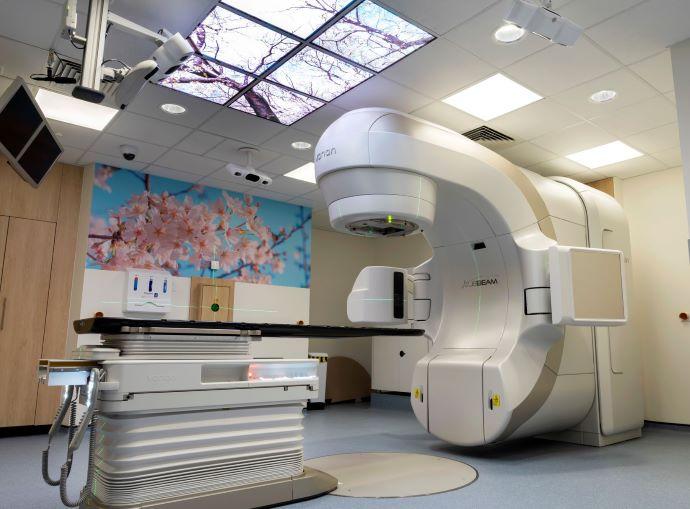Surface Guided Radiotherapy (SGRT) is now being offered to patients receiving radiotherapy treatment, which uses specialist cameras to create a unique 3D outline of the surface of a patient’s body.
Radiotherapy is the use of powerful X-rays to treat cancers. Therapeutic radiographers plan and deliver radiotherapy and traditionally use tattoo marks and X-ray images to ensure patients are positioned correctly. They then monitor patients carefully during their treatment to ensure they stay in the correct position.
The SGRT system called AlignRT, uses light beams and advanced cameras to create a 3D outline of the patient’s body, helping the therapeutic radiographers get the patient into the correct position more accurately and quickly. It can also be used to automatically interrupt treatment if the patient is no longer in the correct position, which is usually a manual task.
The benefits of SGRT are quick and accurate patient positioning, no requirement for tattoo marks and less X-ray image exposure to patients.
At NNUH, the new equipment has been installed on all five TrueBeam linear accelerators (linacs) and the departments dedicated CT scanner. The equipment, made by VisionRT Ltd, has cost over £1m and has been funded from the departments Managed Service Contract, provided through Ergea UK and Ireland Ltd. Alongside the core training provided by VisionRT, the Norfolk and Norwich Hospitals Charity sponsored specialist training days for more than 40 therapeutic radiographers. NNUH will be a reference site for other teams looking to introduce SGRT, passing on what they have learnt.
Jo Thomas, Clinical Operational Manager at NNUH (Therapeutic Radiographer), said: “SGRT is a complete game changer for patients, and we are so excited to be able to use this new technology. Patients don’t need to be handled and moved by us as much, they’re in the treatment room for a shorter time, and it’s much nicer not to have a tattoo, because they’re not left with a visual reminder of a really difficult time, after their treatment has finished.
“The technology is cutting edge. If a patient coughs or sneezes and moves, more than a set tolerance, the beam will cut out and treatment will stop, so that the treatment is only delivered to the intended target. Previously we had to rely on watching patients from outside the treatment room.”
Cambridge University Hospitals has spent £4m on two new TrueBeam linacs, which are fitted with the innovative SGRT system. It will be rolled out to a third linac machine at a later date. Surface Guided Radiotherapy will initially be used to treat patients with breast cancer, with patients no longer needing permanent tattoo markings from January 2026.
In addition to the two new linac machines, colourful artwork and view panels, funded by Addenbrooke’s Charitable Trust, have also been installed to help provide a calm and pleasant environment for patients undergoing radiotherapy treatment.
Andrew Robinson, head of radiotherapy physics at CUH, said: “We’re excited there will now be two centres in the East offering this advanced technology to patients. The SGRT system intuitively provides our radiographers instant visual feedback when setting up patients before treatment. Our teams have worked hard over the summer to test and train on the system, and it is rewarding to see our patients benefitting from the increased accuracy and efficiency of SGRT.”
Sixty-one-year-old Diane Pyle from Tacolneston in Norfolk was the first patient to have SGRT for breast cancer at NNUH. She said: “Having experienced both methods of treatment, I am really pleased and honestly a little excited to have been the first person to have benefitted from the new SGRT. It’s less hands on, there’s no need for pen marks or permanent tattoos and it’s much quicker for me and the really wonderful staff delivering my radiotherapy.”



